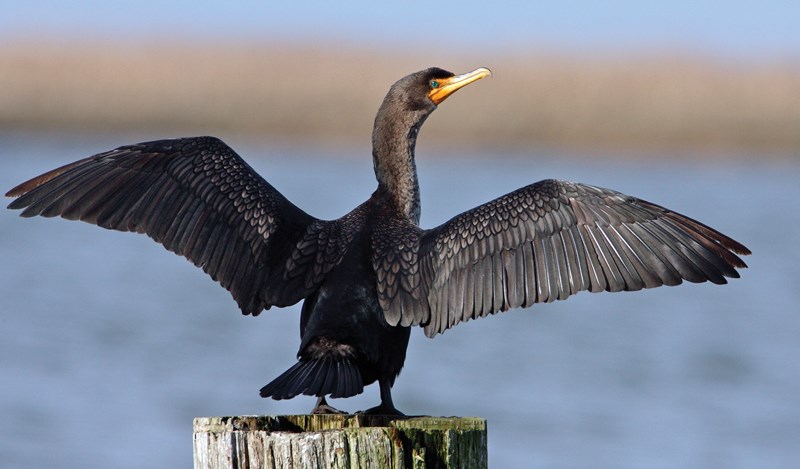The Conservation Area at Maplewood Flats has done it again, with the recent sighting of a rock wren.
This species is normally associated with rock slides in the dry Interior of B.C. along with the canyon wren and white throated swift.
Birds do wander, especially at this time of the year. They are migrating and sometimes veer off course.
Over the years, the sanctuary has had a number of rare sightings. Who can forget the wonderful views of the Tennessee warbler or being close-up to a long-billed curlew? (Consult with Wild Bird Checklist for a complete list of birds, including rarities).
One should always be on the alert for rarities – especially during the fall and winter at bird feeders. If you do see a species that is “out of the ordinary,” it should be properly documented with photos, additional observers and a good description.
Autumn is slowly coming to the sanctuary. Some of the sure signs are colourful leaves, mushrooms, fruits (and seeds), and migrating birds.
Fruits, like the late-ripening cherries, Pacific crab apple and rowan (mountain ash), advertise themselves to birds and other wildlife.
Did you know that coyotes love to eat blackberries and other fruits? Recently we were treated to watching a large flock of cedar waxwings feeding on ripe cherries.
In the fall, neo-tropical species like the black-headed grosbeak, western tanager, warblers and vireos leave the North Shore for their neo-tropical wintering grounds. Maplewood’s purple martins, for example, make their way all the way down to Brazil. Osprey have left, possibly headed for Mexico, Central America or beyond. We wish them well and await their return in spring.
Some species, like many of our shorebirds, stop to rest and feed on the mud flats on their journey to South America to spend the winter. It’s a remarkable migration for thousands of kilometres from the far north to neo-tropical wintering grounds.
A few waders, like the greater yellowlegs, and dunlin, killdeer, along with hundreds of gulls and waterfowl, use the “flats” in winter.
There are no “sea gulls” here – because there is no such thing! There are glaucous-winged, California, mew, ring-billed and others – but no “sea gull.”
Checking the rocky shores of the sanctuary you may be lucky and spot a black turnstone or a black oystercatcher.
The joy of discovery is that you will always see wonderful things at Maplewood, like birds, deer and otters.
Loons and grebes that nested in fresh water lakes in B.C.’s Interior are now arriving “back” to spend the winter here, but in their “winter,” and not breeding, plumage.
Also look for a variety of ducks like the bufflehead, common goldeneye, Barrow’s goldeneye, greater scaup, surf scoter, and if you’re very lucky, a long-tailed duck.
You will always see a collection of cormorants out on the sand and gravel bars. Watch for double-crested cormorants with their wings outstretched in the “wing drying” posture.
Visit the feeding station near the sanctuary office with its feeders (provided by the North Shore’s Wild Birds Unlimited). Watch for hummingbirds and various sparrows like the spotted towhee, song sparrow, fox sparrow and golden-crowned sparrow.
You might even be lucky to spot a locally rare white-throated sparrow or a slate-coloured junco (our usual dark-eyed junco is the Oregon type).
I often get asked, “Do I really need a pair of binoculars to enjoy birds?” My answer, without a doubt, is yes. A good pair of glasses will help you to see details not possible with unaided eyes.
Choose a good pair when buying – they should be waterproof, fog proof, close focusing, bright and sharp and come with an excellent guarantee (lifetime/no fault). They should also have good eye-relief for eye-glass wearers.
It is best to visit your local wild birds store for expert advice on birding binoculars and scopes. What about a “bird squeaker?” It is a great little device for calling in birds.
There is a special feeling in the crisp October air, plenty of colour, mushrooms, spider webs sparkling with morning dew and more.
Enjoy and keep safe.
Al Grass is a naturalist with Wild Bird Trust of British Columbia, which offers free walks at The Conservation Area at Maplewood Flats on the second Saturday of every month. The next walk will be Saturday, Oct. 8 starting at 10 a.m. Participants will look for autumn signs. Meet at WBT’s site office, 2645 Dollarton Hwy., North Vancouver. Walks go rain or shine. wildbirdtrust.org



